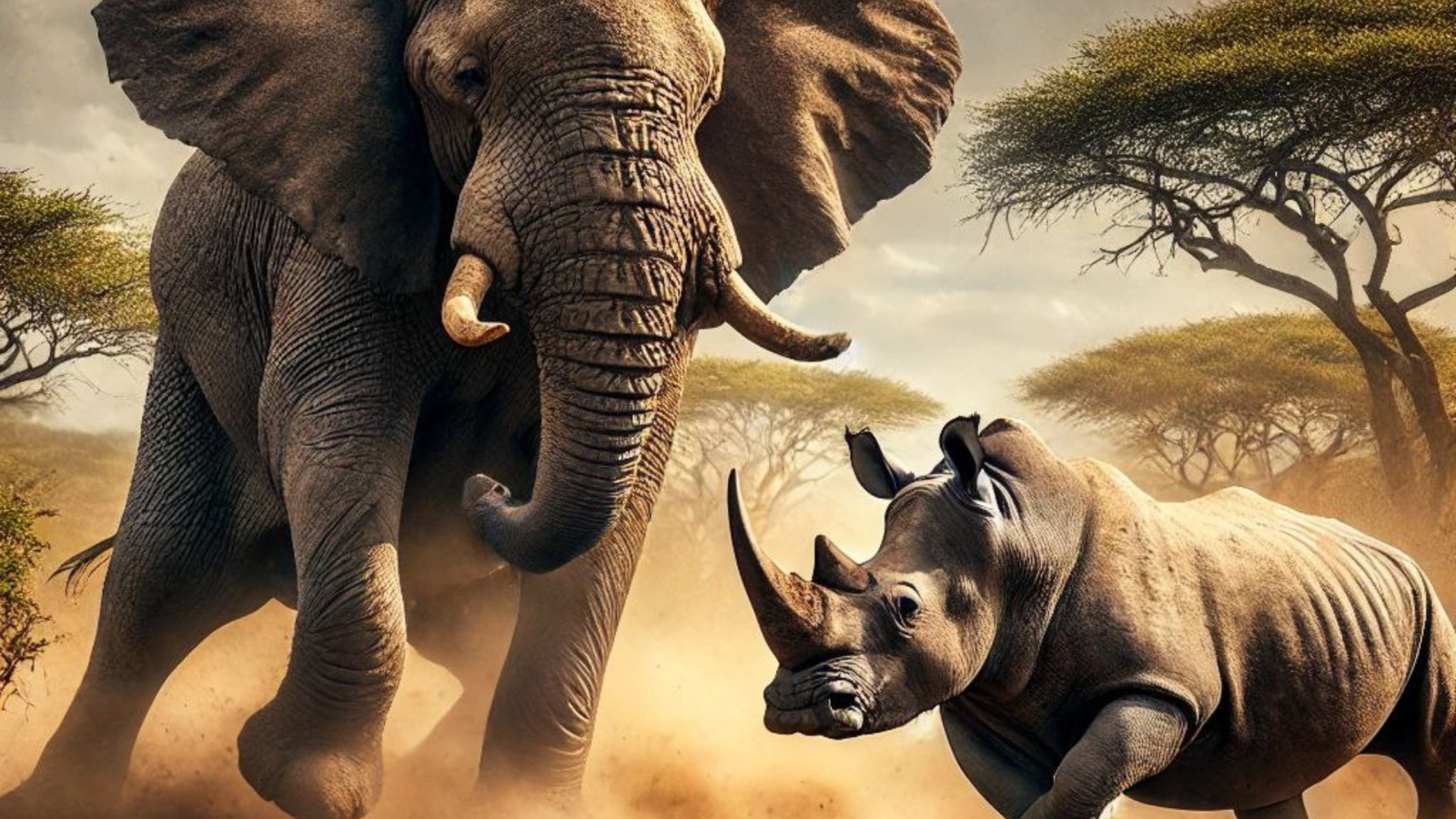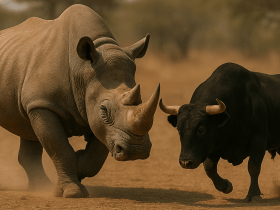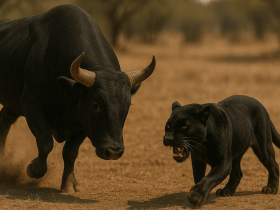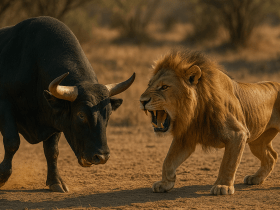The elephant vs rhino who will win? Anyway this is a fascinating exploration of two of the most iconic megafauna in the animal kingdom. While the elephant is known for its intelligence and size, the rhino is celebrated for its strength and armor-like skin. This detailed comparison will delve into every aspect of these magnificent creatures, from their physical attributes to their conservation status. Let’s dive into the scientific details to determine which animal holds the advantage in each category.
Table of Contents
Toggle1. Body Specifications
| Subtopic | Elephant (Loxodonta africana/Elephas maximus) | Rhino (Rhinocerotidae family) | Winner |
|---|---|---|---|
| Height (at shoulder) | 2.5–4 meters | 1.5–1.8 meters (white rhino), 1.2–1.5 meters (black rhino) | Elephant |
| Length (head to tail) | 5.5–7.5 meters | 3.5–4.5 meters | Elephant |
| Weight | 2,000–6,000 kg | 800–2,300 kg | Elephant |
| Body Shape | Large, barrel-shaped body with long trunk | Stocky, barrel-shaped body with thick skin | Tie |
| Bone Density | High bone density for supporting massive weight | High bone density for strength | Tie |
| Muscle Mass | 40–50% of body weight | 50–60% of body weight | Rhino |
| Tail Length | 1–1.5 meters | 0.6–0.7 meters | Elephant |
| Skin Thickness | 2.5 cm | 1.5–5 cm | Rhino |
| Neck Strength | Strong neck muscles for lifting | Strong neck muscles for charging | Tie |
| Overall Size | Larger and heavier | Smaller and lighter | Elephant |
2. Coat and Coloration
| Subtopic | Elephant | Rhino | Winner |
|---|---|---|---|
| Base Color | Gray | Gray (white rhino), Dark gray (black rhino) | Tie |
| Pattern | Wrinkled skin with sparse hair | Thick, folded skin with no hair | Tie |
| Melanin Levels | Normal melanin distribution | Normal melanin distribution | Tie |
| Skin Texture | Rough, wrinkled | Thick, armor-like | Rhino |
| Skin Function | Protects from sun and insects | Protects from predators and sun | Tie |
| Reflectivity | Low reflectivity | Low reflectivity | Tie |
| Calf Coloration | Gray with sparse hair | Gray with smoother skin | Tie |
| Seasonal Changes | Minimal | Minimal | Tie |
| Unique Markings | Wrinkles and ear patterns | Skin folds and horn patterns | Tie |
| Thermoregulation | Uses ears and mud to cool down | Uses mud to cool down | Elephant |
3. Habitat and Range
| Subtopic | Elephant | Rhino | Winner |
|---|---|---|---|
| Geographic Range | Africa, Asia | Africa, Asia (limited) | Elephant |
| Habitat Type | Savannas, forests, deserts | Grasslands, savannas, swamps | Tie |
| Adaptability | Highly adaptable to various climates | Prefers specific habitats | Elephant |
| Climate Preference | Warm to tropical | Warm to tropical | Tie |
| Territory Size | 10–70 km² | 5–20 km² | Elephant |
| Elevation Range | Up to 3,000 meters | Up to 2,000 meters | Elephant |
| Human Proximity | Can live near human settlements | Avoids human settlements | Elephant |
| Migration Patterns | Seasonal migrations | Non-migratory | Elephant |
| Endangered Habitats | Losing habitats to deforestation | Losing habitats to poaching | Tie |
| Range Overlap | Overlaps with rhinos in some regions | Overlaps with elephants in some regions | Tie |
4. Diet and Hunting – Elephant vs Rhino who will win
| Subtopic | Elephant | Rhino | Winner |
|---|---|---|---|
| Diet Type | Herbivore (browsing and grazing) | Herbivore (grazing and browsing) | Tie |
| Daily Caloric Intake | 150,000–300,000 kcal | 20,000–30,000 kcal | Elephant |
| Feeding Techniques | Uses trunk to gather food | Uses lips to graze and browse | Tie |
| Food Consumption | 150–300 kg/day | 50–100 kg/day | Elephant |
| Water Consumption | 100–200 liters/day | 30–50 liters/day | Elephant |
| Foraging Range | 10–50 km/day | 5–10 km/day | Elephant |
| Digestive System | Less efficient (40% digestion) | More efficient (60% digestion) | Rhino |
| Food Storage | Does not store food | Does not store food | Tie |
| Competition | Competes with rhinos and other herbivores | Competes with elephants and other herbivores | Tie |
| Overall Diet | More varied diet | Less varied diet | Elephant |
5. Strength and Bite Force
| Subtopic | Elephant | Rhino | Winner |
|---|---|---|---|
| Bite Force (PSI) | 2,000 PSI | 1,000 PSI | Elephant |
| Tusk/Horn Strength | Strong tusks for digging and defense | Strong horn for defense | Tie |
| Lifting Capacity | Can lift 300–400 kg with trunk | Cannot lift objects | Elephant |
| Jaw Muscles | Powerful jaw muscles | Strong jaw muscles | Elephant |
| Charging Force | Can charge at 25 km/h | Can charge at 50 km/h | Rhino |
| Limb Strength | Strong legs for supporting weight | Strong legs for charging | Tie |
| Bone Crushing Ability | Can crush trees | Cannot crush bones | Elephant |
| Swatting Force | Can swat with trunk | Cannot swat | Elephant |
| Grip Strength | Strong grip with trunk | No grip strength | Elephant |
| Overall Strength | Stronger in most aspects | Stronger in charging | Elephant |
6. Speed and Agility
| Subtopic | Elephant | Rhino | Winner |
|---|---|---|---|
| Top Speed | 25 km/h | 50 km/h | Rhino |
| Acceleration | Slow acceleration | Fast acceleration | Rhino |
| Agility in Terrain | Less agile due to size | More agile on flat terrain | Rhino |
| Swimming Ability | Excellent swimmer | Moderate swimmer | Elephant |
| Stamina | High stamina for long distances | Low stamina for short bursts | Elephant |
| Jumping Height | Cannot jump | Cannot jump | Tie |
| Jumping Distance | Cannot jump | Cannot jump | Tie |
| Climbing Ability | Cannot climb | Cannot climb | Tie |
| Maneuverability | Less maneuverable | More maneuverable | Rhino |
| Overall Agility | Less agile | More agile | Rhino |
7. Senses
| Subtopic | Elephant | Rhino | Winner |
|---|---|---|---|
| Vision Acuity | Poor eyesight | Poor eyesight | Tie |
| Hearing Range | Can hear low-frequency sounds (1–20 kHz) | Can hear low-frequency sounds (1–20 kHz) | Tie |
| Olfactory Capabilities | Excellent sense of smell | Excellent sense of smell | Tie |
| Depth Perception | Poor | Poor | Tie |
| Color Vision | Limited color vision | Limited color vision | Tie |
| Motion Detection | Highly sensitive | Highly sensitive | Tie |
| Low Light Vision | Poor | Poor | Tie |
| Sensory Whiskers | No whiskers | No whiskers | Tie |
| Auditory Localization | Precise | Precise | Tie |
| Overall Senses | Strong sense of smell and hearing | Strong sense of smell and hearing | Tie |
8. Reproduction and Lifespan
| Subtopic | Elephant | Rhino | Winner |
|---|---|---|---|
| Gestation Period | 22 months | 15–16 months | Rhino |
| Litter Size | 1 calf | 1 calf | Tie |
| Calf Mortality Rate | 30–40% | 40–50% | Elephant |
| Sexual Maturity Age | 10–12 years | 5–7 years | Rhino |
| Lifespan (Wild) | 60–70 years | 35–50 years | Elephant |
| Lifespan (Captivity) | 70–80 years | 40–50 years | Elephant |
| Parental Care | Mother and herd raise calf | Mother raises calf alone | Elephant |
| Weaning Age | 2–3 years | 1–2 years | Rhino |
| Interbirth Interval | 4–5 years | 2–3 years | Rhino |
| Reproductive Success | Lower due to long gestation | Higher due to shorter gestation | Rhino |
9. Social Behavior
| Subtopic | Elephant | Rhino | Winner |
|---|---|---|---|
| Social Structure | Highly social (herds) | Solitary or small groups | Elephant |
| Territorial Range | 10–70 km² | 5–20 km² | Elephant |
| Communication Methods | Vocalizations, infrasound, body language | Vocalizations, scent marking | Elephant |
| Aggression Levels | Low aggression | High aggression | Rhino |
| Mating Behavior | Polygamous | Polygamous | Tie |
| Calf Interaction | Herd raises calves | Mother raises calf alone | Elephant |
| Territorial Marking | Scent marking and vocalizations | Scent marking and dung piles | Tie |
| Conflict Resolution | Avoidance and posturing | Physical fights | Elephant |
| Group Size | 10–20 individuals | 1–5 individuals | Elephant |
| Overall Sociability | Highly social | Less social | Elephant |
10. Conservation Status
| Subtopic | Elephant | Rhino | Winner |
|---|---|---|---|
| IUCN Status | Vulnerable (African), Endangered (Asian) | Vulnerable (white rhino), Critically Endangered (black rhino) | Elephant |
| Population Trends | Declining | Declining | Tie |
| Threats | Poaching, habitat loss | Poaching, habitat loss | Tie |
| Conservation Efforts | Strict anti-poaching laws | Strict anti-poaching laws | Tie |
| Wild Population | ~415,000 (African), ~40,000 (Asian) | ~18,000 (white rhino), ~5,500 (black rhino) | Elephant |
| Captive Population | ~10,000 individuals | ~1,000 individuals | Elephant |
| Genetic Diversity | Higher due to larger populations | Lower due to fragmented populations | Elephant |
| Reintroduction Success | Moderate success | Limited success | Elephant |
| Public Awareness | High | High | Tie |
| Future Outlook | Critical | Critical | Tie |
Conclusion
In the elephant vs rhino debate, each animal excels in different areas. Elephants dominate in size, intelligence, and social behavior, while rhinos showcase superior speed, agility, and aggression. Both animals face significant threats due to habitat loss and poaching, making their conservation a global priority.
References
- IUCN Red List: www.iucnredlist.org
- National Geographic: www.nationalgeographic.com
- Smithsonian’s National Zoo: nationalzoo.si.edu
- Journal of Mammalogy: academic.oup.com
- Wildlife Conservation Society: www.wcs.org
By understanding the unique traits of these majestic creatures, we can better appreciate their roles in the ecosystem and work towards their preservation. Whether it’s the elephant vs rhino, both deserve our respect and protection.






Leave a Reply